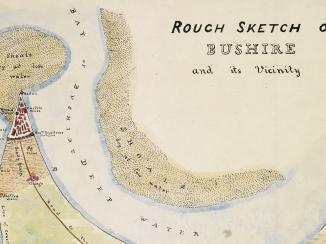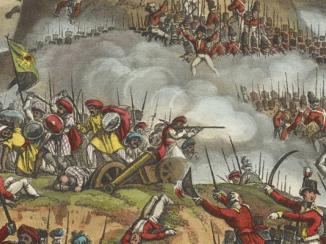Overview
What are the IOR/F/4 records?
The IOR/F/4 items are part of the IOR/F Series, which relates to the records of the Board of Control. These items are copies, made for the Board of Control Formally known as the Board of Commissioners for the Affairs of India, it was established by an Act of Parliament in 1784 to supervise the activities of the East India Company. , of dispatches sent to London from the governments in India (Bombay, Madras, and Bengal) during the period 1796-1858.
Each of the Indian governments was responsible for specific regions, and the Gulf came under the purview of the Bombay Government. When the dispatches, comprising letters and enclosures, arrived in London, they were read by the Court of Directors The London-based directors of the East India Company who dealt with the daily conduct of the Company's affairs. . They were then usually sent to the appropriate department within the East India Company (EIC), which would draft a response. Each IOR/F/4 item typically covers one topic, and as such, generally only involves letters from one department belonging to one of the Indian governments. These departments included the Political, Public, Judicial, Military, Naval, and Secret. Originally all departments except the Secret were represented in the IOR/F/4 Series, but the collection was heavily weeded around 1860, resulting in the majority of the F/4 items which remain deriving from the Political Department.
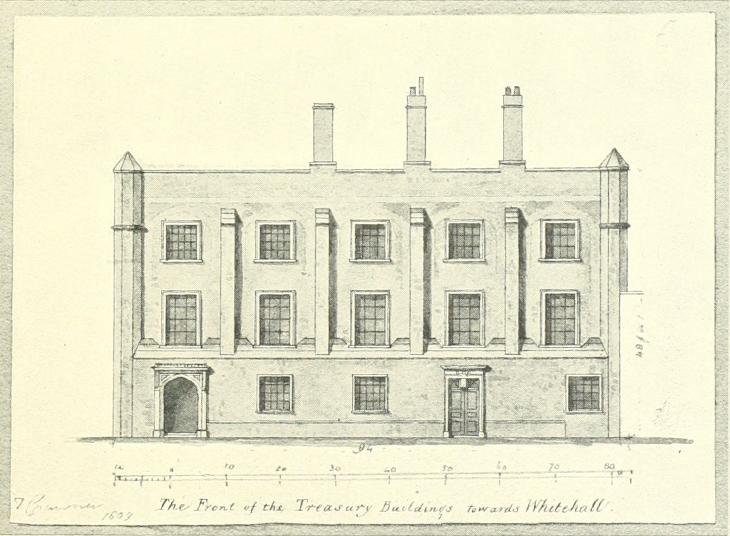
The EIC’s draft response was sent to the Board of Control Formally known as the Board of Commissioners for the Affairs of India, it was established by an Act of Parliament in 1784 to supervise the activities of the East India Company. along with copies of all the relevant letters and enclosures which had come from India. These copies form the IOR/F/4 items. The Board might request alterations, which would then be made by the department. The final draft, again with the IOR/F/4 items, would be resent to the Board of Control Formally known as the Board of Commissioners for the Affairs of India, it was established by an Act of Parliament in 1784 to supervise the activities of the East India Company. to be checked one last time, before it was sent as a dispatch from the Court of Directors The London-based directors of the East India Company who dealt with the daily conduct of the Company's affairs. to the Indian government. The finished draft became a dispatch to India, and is now part of the IOR/E/4 Series.
To date, the Qatar Digital Library (QDL) only hosts the IOR/F/4 records which relate to the Gulf. A more general description of the entire Series is available through the British Library’s Archives and Manuscripts online catalogue entry.
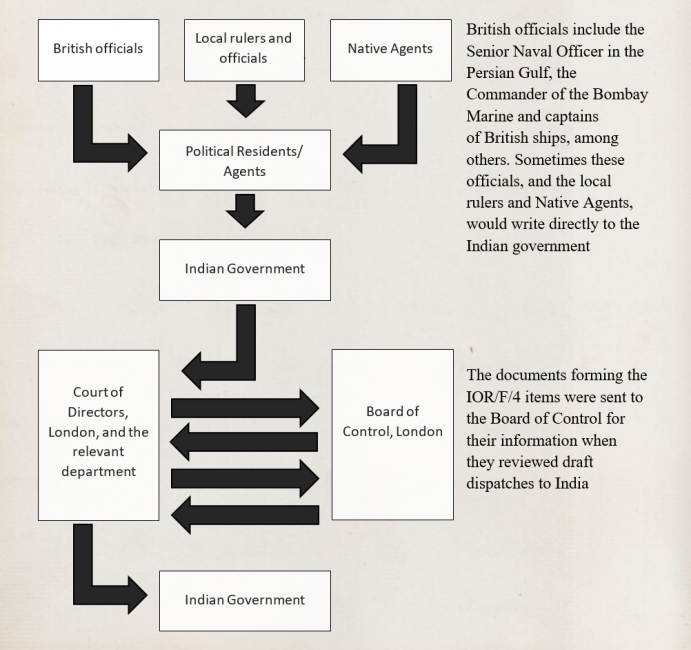
How are the records arranged and what subjects do they cover?
The physical arrangement of the IOR/F/4 Series follows the draft numbers and dates of the Court’s outgoing dispatches and is roughly chronological. The material is arranged into volumes, with each containing multiple items. Thus, in the reference number IOR/F/4/1399/55442, for example, 1399 represents a volume and 55442 represents an item.
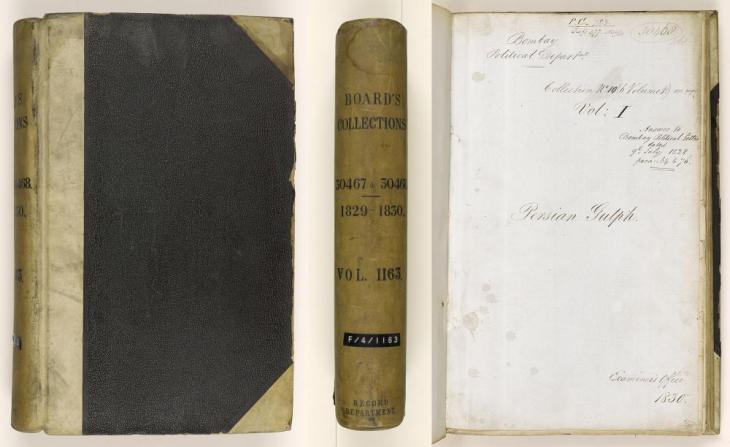
Each IOR/F/4 item begins with a title page and, in many cases, a table of contents. Earlier items from the late eighteenth and early nineteenth century tend to be less organised, but material from the 1820s onwards is more consistent in structure. After the title page and contents, items tend to begin with an extract of a Political Letter from the Government of Bombay From c. 1668-1858, the East India Company’s administration in the city of Bombay [Mumbai] and western India. From 1858-1947, a subdivision of the British Raj. It was responsible for British relations with the Gulf and Red Sea regions. to the Court of Directors The London-based directors of the East India Company who dealt with the daily conduct of the Company's affairs. , which acts as an introduction to the subject(s) at hand, and sets out any requests for instructions. The subjects range widely from general updates on affairs in the Gulf to specific incidents, such as new appointments or the death of an official. There may be multiple Political Letters if the subject(s) had been discussed previously between the government and the Court. The rest of the item ordinarily consists of extracts from the Bombay Political Consultations.
Consultations were records of the Indian governments’ transactions or proceedings. During these transactions, letters sent to the Government of Bombay From c. 1668-1858, the East India Company’s administration in the city of Bombay [Mumbai] and western India. From 1858-1947, a subdivision of the British Raj. It was responsible for British relations with the Gulf and Red Sea regions. (mostly by Political Residents) would be considered along with any enclosures to those letters (see Figures 1 and 2). Enclosures could include copies of relevant papers such as treaties, petitions, excerpts from ships’ journals, trade documents, and other letters. Therefore, the extracts of Consultations contain letters and enclosures, interspersed with minutes and resolutions reached by the government, as well as any subsequent governmental letters written as a result of the transaction. References to older letters that turned out to be relevant to the topic at hand, as well as delays in the delivery of letters, mean that the material within an item may not appear in strict chronological order. However, the extracts of Consultations are arranged chronologically.
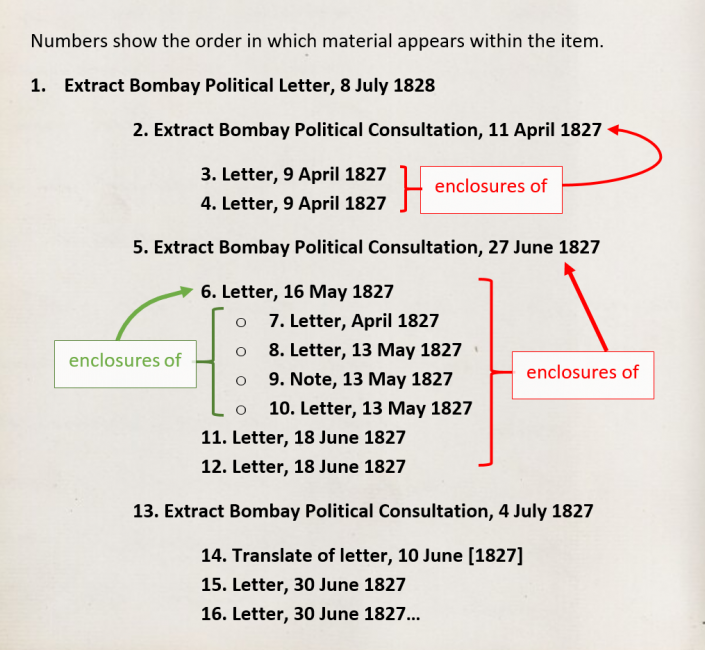
Relationship with other records
As mentioned above, one of the most important series related to IOR/F/4 is the IOR/E/4 Series. While this Series is not currently on the QDL, references to relevant E/4 items are listed under the ‘related material’ section of each F/4 item’s catalogue description.
Since F/4 items consist of copies of other IOR records, they frequently overlap with other IOR series. This can be seen in the IOR/R/15 Series, several subdivisions of which are on the QDL.
For example, IOR/F/4/258/5655 contains a copy of an extract from a letter by Hovhannes Paitkhim, an Armenian in Tehran, to the Resident at Bushire. An earlier copy appears in IOR/R/15/1/10 as an enclosure to a series of letters from the Resident to the Government of Bengal From c. 1758-1858, the East India Company's administration in Bengal. From 1773-1833, the most senior of the three subdivisions of India, also known as the Supreme Government of India. From 1858-1947, a subdivision of the British Raj. , forwarding intelligence about French diplomatic activities at the Persian Court.
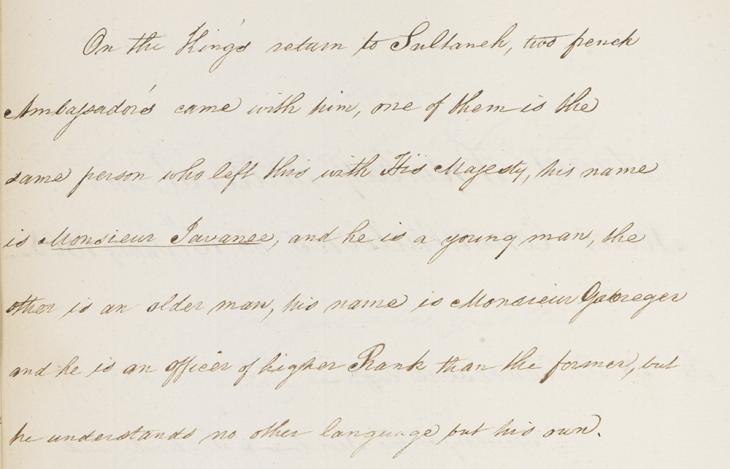
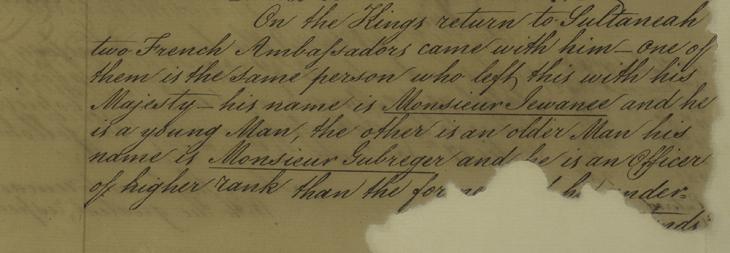
Some of the intelligence is duplicated in IOR/F/4/258/5655. However, the item also contains intelligence on the same topic received from Basra and Muscat, as well as correspondence between the governments of Bombay and Bengal and the Commander-in-Chief of the Royal Navy East Indies Station, discussing how to respond.
This illustrates the value of the F/4 Series in bringing together records from different times and places on the same subjects. Moreover, helpfully for the reader, these records were usually copied by a single scribe, making them easier to follow than some earlier copies. By examining an F/4 item, a researcher can trace the development of a specific event or topic, seeing both the range of information sent from different posts and sources in the Gulf, and the ways in which the governments of India responded to and discussed this information. The F/4 items therefore provide considerable insight into the large-scale maintenance and management of the British presence in the Gulf over several decades, as well as the intricate processes of decision-making and policy formation at the time.
